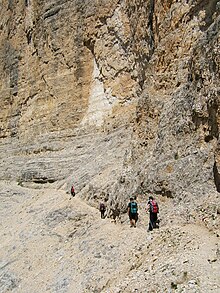
Mountaineering, mountain climbing, or alpinism is a set of outdoor activities that involves ascending mountains. Mountaineering-related activities include traditional outdoor climbing, skiing, and traversing via ferratas that have become sports in their own right. Indoor climbing, sport climbing, and bouldering are also considered variants of mountaineering by some, but are part of a wide group of mountain sports.

Trail riding is riding outdoors on trails, bridle paths, and forest roads, but not on roads regularly used by motorised traffic. A trail ride can be of any length, including a long distance, multi-day trip. It originated with horse riding, and in North America, the equestrian form is usually called "trail riding," or, less often "hacking." In the UK and Europe, the practice is usually called horse or pony trekking.

Scrambling is a mountaineering term for ascending steep terrain using one's hands to assist in holds and balance. It is also used to describe terrain that falls between hiking and rock climbing.

Glossary of climbing terms relates to rock climbing, mountaineering, and to ice climbing.

The mountain goat, also known as the Rocky Mountain goat, is a cloven-footed mammal that is endemic to the remote and rugged mountainous areas of western North America. A subalpine to truly alpine species, it is a sure-footed climber commonly seen on sheer rock faces, near-vertical cliffs and icy passages. Mountain goats generally avoid venturing down into lower elevations—except during seasonal food shortages or during particularly bad weather—as the extreme elevation which they inhabit is their primary defense against predators such as black and brown bears, pumas and wolves.
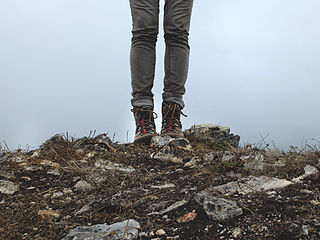
Hiking (walking) boots are footwear specifically designed for protecting the feet and ankles during outdoor walking activities such as hiking. They are one of the most important items of hiking gear since their quality and durability can determine a hiker's ability to walk long distances without injury. Hiking boots are constructed to provide comfort for walking considerable distances over rough terrain. Boots that protect the hiker's feet and heel are recommended. Hiking boots give ankle support and are fairly stiff. A less popular alternative is to use light trainers with thin soles. Footwear should be neither too loose nor too tight, to help prevent blisters and sore feet. Hiking socks that wick sweat from the feet, provide warmth, and cushion the feet are recommended and a thin, inner sock may also help. Most hiking boots are also designed for other outdoor activities such as backpacking, climbing, mountaineering, and hunting.

A mobility scooter is an electric personal transporter used as mobility aid for people with physical impairment, mostly auxiliary to a powered wheelchair but configured like a motorscooter. When motorized they function as micromobility devices and are commonly referred to as a powered vehicle/scooter, or electric scooter. Non-motorized mobility scooters are less common, but are intended for the estimated 60% of wheelchair users who have at least some use of their legs. Whilst leg issues are commonly assumed to be the reason for using scooters, the vehicles are used by those with a wide range of conditions from spinal injuries to neurological disorders.

The Teufelshörner are a pair of mountains on the German-Austrian border in the Berchtesgaden Alps. The two peaks, which form a mountain ridge, are the Großes Teufelshorn and the Kleines Teufelshorn.

The Salober ist a 2,088 -high grass mountain in the Allgäu Alps. It lies northeast of the Laufbacher Eck.

The Stadelhorn (2,286 m) is the highest and most prominent peak in the Reiter Alm on the Austro-German border, lying on the boundary between the states of Bavaria and Salzburg.
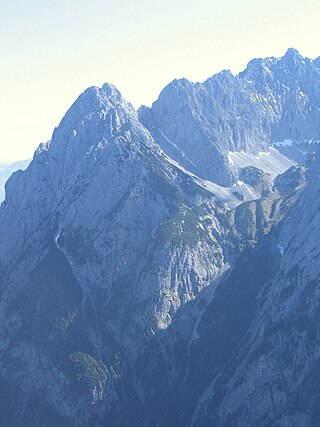
The Lärchegg is a 2,123-metre-high (6,965 ft) mountain in the Kaisergebirge range of the Northern Limestone Alps in Austria.

The Sonneck is a 2,260-metre-high (7,410 ft) mountain in the Kaisergebirge range of the Northern Limestone Alps in Austria. On its broad peak stands a solid summit cross, the panorama is comprehensive and there are particularly good views of the Ellmauer Halt, the highest mountain in the range, the Treffauer and Lake Hinterstein.

At 2,304 metres (7,559 ft), the Treffauer is the third highest mountain in the Kaisergebirge range of the Alps. It lies in the Austrian state of Tyrol.

The Steinbergstein is a mountain, 2,215 m (AA) (7,267 ft) high, in the Kitzbühel Alps in Austria.
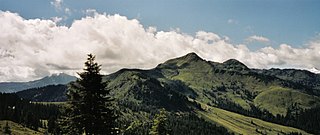
The Brechhorn is a 2,032 m above sea level (AA) high mountain in the Kitzbühel Alps in Austria. It lies between the valleys of the Aschauer Ache and the Windau.

An alpine route or high alpine route is a trail or climbing route through difficult terrain in high mountains such as the Alps, sometimes with no obvious path. In the Alps, the various alpine clubs define and mark an alpine route, also called alpinweg or alpinwanderweg. More generally, the term is used for routes of crossing the Alps, such as Roman crossings and Napoleon crossing the Alps. It is also used to describe routes in other mountains with alpine conditions.

Exposure is a climbing and hiking term. Sections of a hiking path or climbing route are described as "exposed" if there is a high risk of injury in the event of a fall because of the steepness of the terrain. If such routes are negotiated without any protection, a false step can result in a serious fall. The negotiation of such routes can cause fear of falling because of the potential danger.
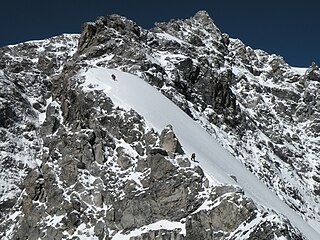
A high mountain tour is extended multi-day hiking and scrambling that takes place in the higher-altitude zone that is covered by ice all year round, the nival zone. High mountain tours require special additional preparation and equipment to the standard hiking and scrambling requirements.

The Noppenspitze is a rocky summit, 2,594 metres high, in the central part of the Hornbach chain of the Allgäu Alps.
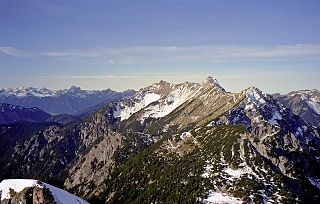
The Geierköpfe form a triple-summited mountain massif in the Ammergau Alps in Tyrol, Austria. The main summit is 2,161 m (AA) high, the West Top 2,143 m high and the East Top 2,060 m. The summit group is located southwest of the Ammer Saddle.

